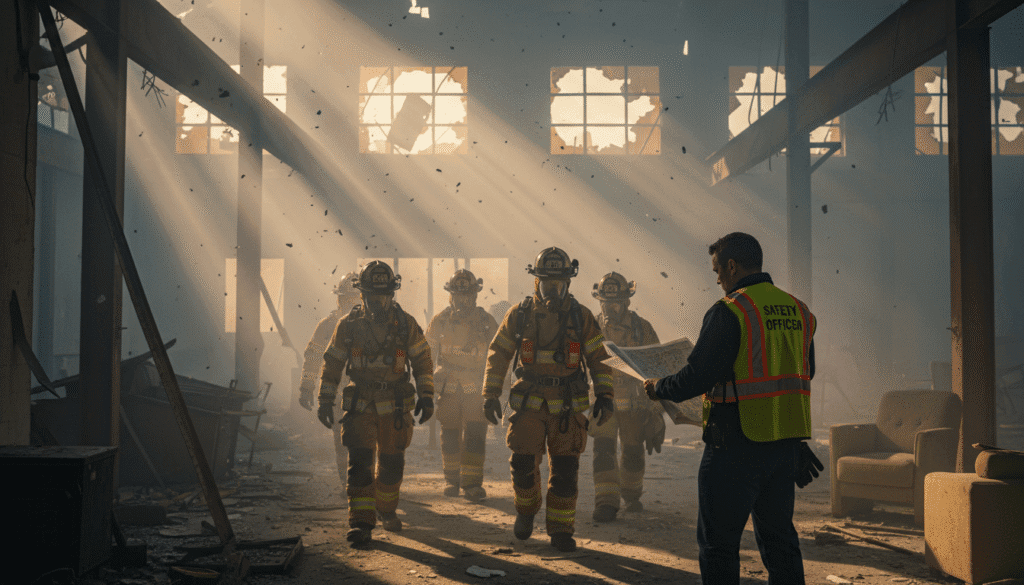Firefighters and first responders are subjected to many dangers every time they enter a burning or destroyed building, but one of the most lethal and least observed killers is asbestos exposure. The majority of buildings constructed before asbestos bans contain the material in insulation, tiles, pipes, or ceiling tiles. When structural failure or fire disrupts these substances, microscopic asbestos fibers are released into the air and remain suspended for many years. Upon inhalation, they may create severe respiratory diseases, including asbestosis and mesothelioma, years later.
Asbestos surveys play a critical role in identifying and regulating these hidden hazards, allowing emergency teams to take protective action before exposure. By knowing where the asbestos is, safety can be designed that reconciles fast response with enduring health.
Discovering Concealed Dangers Before They Trigger Catastrophes
The main purpose of an asbestos survey is to find all asbestos-containing materials within a building and assess their condition. To fire personnel, this intelligence is precious because it determines how safely they can enter a building during a fire or rescue operation. Asbestos products, when they are disturbed by fire, heat, or water pressure, fragment into invisible dust particles that become airborne. Without prior knowledge of asbestos locations, rescue workers risk inhaling unseen fibers while performing their duties.
An effective survey provides building managers, safety personnel, and emergency planners with information to help them identify which areas are most vulnerable. This allows specialized measures, such as increased ventilation systems or protective gear procedures, to be applied to allow responders to operate without endangering their long-term health. Asbestos surveys therefore constitute a good precautionary action that protects both the responders and the public they serve.
How Surveys Make Emergency Planning and Safety Easier
Fire incidents occur quickly, and firefighters often have seconds, if not fractions of a second, in which to determine where to enter, ventilate, or extinguish fires. Having accurate asbestos survey data to plan with is a confidence-builder for response teams. Knowing which parts of a building contain asbestos allows the command officer to chart safe entry and avoidance areas. It enforces provision for deployment of measures of containment that minimize release of fibers when fire suppression occurs.
In urban centers such as London, where there is a high rate of historical and older buildings remaining in routine use, such information is particularly significant. Emergency surveys conducted before emergencies happen not only protect first responders but also prevent pollution by asbestos in nearby roads or even surrounding buildings. By being able to access such reports, local fire stations are able to train staff accordingly and maintain safety precautions in actual occurrences. Such foresight makes a latent risk an assured threat, increasing the safety of emergency personnel as well as civilians.
Decreasing Exposure Through Informed Response Mechanisms
In case there is an asbestos survey, fire stations are able to modify response mechanisms more easily. For example, when a building is known to contain asbestos and a fire breaks out, firefighters can adapt by employing less aggressive ventilation strategies or applying water strategically to control fibers from dispersing. They can utilize proper respiratory protection for high-risk environments and follow decontamination procedures immediately after the incident. Survey reports typically include detailed maps and condition reports noting what materials are friable and therefore more dangerous in the case of fire.
This data allows crews to focus on measures to save lives while avoiding unnecessary exposure. Finally, following the extinguishment of the fire, cleanup crews can utilize the same survey data to safely handle debris so asbestos will not become airborne again when it is removed or disposed of.
Long-Term Health Protection of Firefighters
The long-term health effects of asbestos exposure to firefighters have been extensively recorded, with research indicating that occupational exposure can cause higher rates of cancer and respiratory disease. Given that symptoms can take years to develop, the most effective type of prevention is not becoming exposed in the first place. Asbestos surveys are an important factor in reducing cumulative risk, enabling departments to create safer operating practices.
Keeping asbestos records up-to-date also allows fire departments to track exposure cases and decide whether follow-up medical screening is warranted for personnel who have attended fires in asbestos-contaminated atmospheres. Implementing asbestos awareness within fire training ensures that the newest hires understand the importance of respiratory protection and contamination control. This culture of prevention safeguards not only today’s responders but also those who will respond in the future and lose their lives serving emergency services.
Shielding Communities from Recovery and Cleanup
Asbestos inspection has its role to play beyond the early response phase. After a fire, buildings would require thorough cleanup and reconstruction. When asbestos products are disturbed, they propagate contamination to the air, ground, and neighboring properties. Environmental teams can rapidly isolate contaminated sites and prevent further public exposure through existing asbestos survey data.
This is especially crucial in urban settings where multiple buildings share interconnects via ventilation systems or neighboring sites. Fire departments can also assist with cooperation from environmental agencies and building owners to ensure rehabilitation following a fire happens in alignment with safety protocols. Therefore, society is left with a cleaner, safer building process that protects citizens and builders alike.
A Worth It Investment in Preparedness That Saves Lives
The benefit of asbestos surveys is that they have the ability to translate uncertain hazards into managed safety data. For firefighters and first responders, seconds are critical, and having a clue what is inside building walls can be the difference between a successful rescue and an exposure that alters a life. With the incorporation of prevention into education and planning, asbestos surveys enable emergency responders to do their work with confidence. They ensure compliance with regulatory health and safety standards, reducing property owners’ liability while improving community resilience as a whole.
Lastly, asbestos surveys are a joint agreement between building managers and emergency responders to prioritize human life over building damage. Asbestos surveys protect firefighters and first responders from one of the sneakiest hazards found in aging buildings. By identifying and mapping asbestos-containing materials, they allow emergency crews to work with caution guarded, reducing the potential for exposure during fires and cleanup.
They also facilitate long-term monitoring of health, increase community safety, and promote collaboration between property owners and emergency agencies. For firefighters putting their lives at risk on a daily basis, such anticipatory measures are a priceless extra measure of safety. Asbestos awareness based on good asbestos information secures not only those who reach the site of disasters but also ensures healthier workplaces for all other people affected by accidents of fire.


